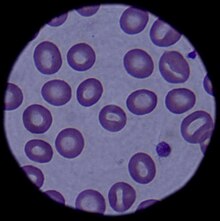Blood cell: Difference between revisions
Added image |
|||
| Line 26: | Line 26: | ||
==Red blood cells (Erythrocytes)== |
==Red blood cells (Erythrocytes)== |
||
{{main|Red blood cell}} |
{{main|Red blood cell}} |
||
Red blood cells are primarily for carrying [[oxygen]] and some [[carbon dioxide]] through the use of [[hemoglobin]] and have a lifetime of about 120 days. In the process of being formed they go through being a stem cell, a monopotent stem cell, a Proerythroblast, Erythroblast, reticulocyte, and then becomes a red blood cell carrying glucose. These cells are also known as erythrocytes. |
Red blood cells are primarily for carrying [[oxygen]] and some [[carbon dioxide]] through the use of [[hemoglobin]] and have a lifetime of about 120 days. In the process of being formed they go through being a stem cell, a butthole |
||
monopotent stem cell, a Proerythroblast, Erythroblast, reticulocyte, and then becomes a red blood cell carrying glucose. These cells are also known as erythrocytes. |
|||
==White blood cells (Leukocytes)== |
==White blood cells (Leukocytes)== |
||
Revision as of 17:56, 24 October 2011

A blood cell, also called a hematocyte, is a cell normally found in blood. In mammals, these fall into three general categories:
- red blood cells — Erythrocytes
- white blood cells — Leukocytes
- platelets — Thrombocytes
Together, these three kinds of blood cells add up to a total 45% of the blood tissue by volume, with the remaining 55% of the volume composed of plasma, the liquid component of blood.[1] This volume percentage (e.g., 45%) of cells to total volume is called hematocrit, determined by centrifuge or flow cytometry. Hemoglobin (the main component of red blood cells) is an iron-containing protein which facilitates transportation of oxygen and other respiratory gases to tissues.
Red blood cells (Erythrocytes)
Red blood cells are primarily for carrying oxygen and some carbon dioxide through the use of hemoglobin and have a lifetime of about 120 days. In the process of being formed they go through being a stem cell, a butthole monopotent stem cell, a Proerythroblast, Erythroblast, reticulocyte, and then becomes a red blood cell carrying glucose. These cells are also known as erythrocytes.
White blood cells (Leukocytes)
White blood cells, or leukocytes (also spelled "leucocytes", leuco- Ancient Greek "white"), are cells of the immune system involved in defending the body against both infectious disease and foreign materials. Five[1] different and diverse types of leukocytes exist, but they are all produced and derived from a multipotent cell in the bone marrow known as a hematopoietic stem cell. They live for about 3 to 4 days in the average human body. Leukocytes are found throughout the body, including the blood and lymphatic system.
Platelets (Thrombocytes)
Platelets, or thrombocytes (from Greek θρόμβος, "clot" and κύτος, "cell"), are small, irregularly shaped clear cell fragments (i.e. cells that do not have a nucleus containing DNA), 2–3 µm in diameter, which are derived from fragmentation of precursor megakaryocytes. The average lifespan of a platelet is normally just 5 to 9 days. Platelets are a natural source of growth factors. They circulate in the blood of mammals and are involved in hemostasis, leading to the formation of blood clots.
If the number of platelets is too low, excessive bleeding can occur. However, if the number of platelets is too high, blood clots can form (thrombosis), which may obstruct blood vessels and result in such events as a stroke, myocardial infarction, pulmonary embolism or the blockage of blood vessels to other parts of the body, such as the extremities of the arms or legs. An abnormality or disease of the platelets is called a thrombocytopathy, which could be either a low number of platelets (thrombocytopenia), a decrease in function of platelets (thrombasthenia), or an increase in the number of platelets (thrombocytosis). There are disorders that reduce the number of platelets, such as heparin-induced thrombocytopenia (HIT) or thrombotic thrombocytopenic purpura (TTP) that typically cause thromboses, or clots, instead of bleeding.
Platelets release a multitude of growth factors including Platelet-derived growth factor (PDGF), a potent chemotactic agent, and TGF beta, which stimulates the deposition of extracellular matrix. Both of these growth factors have been shown to play a significant role in the repair and regeneration of connective tissues. Other healing-associated growth factors produced by platelets include basic fibroblast growth factor, insulin-like growth factor 1, platelet-derived epidermal growth factor, and vascular endothelial growth factor. Local application of these factors in increased concentrations through Platelet-rich plasma (PRP) has been used as an adjunct to wound healing for several decades
References
- ^ Maton, Anthea (1993). Human Biology and Health. Englewood Cliffs, New Jersey, USA: Prentice Hall. ISBN 0-13-981176-1.
{{cite book}}: Unknown parameter|coauthors=ignored (|author=suggested) (help)
External links
- What is Blood? from the Genetic Science Learning Center at the University of Utah.
- Cells of the blood
